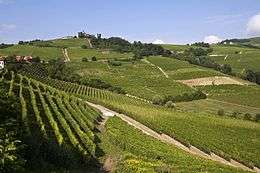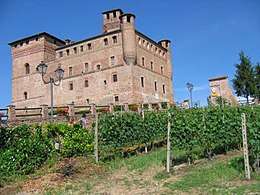Vineyard Landscape of Piedmont: Langhe-Roero and Monferrato
Vineyard Landscape of Piedmont: Langhe-Roero and Monferrato is the official name of a UNESCO World Heritage Site comprising "five distinct wine-growing areas with outstanding landscapes" plus the Castle of Grinzane Cavour in the region of Piedmont, Italy.[1]
| UNESCO World Heritage Site | |
|---|---|
 | |
| Location | Province of Cuneo, Province of Asti, Province of Alessandria, Italy |
| Includes |
|
| Criteria | Cultural: (iii), (v) |
| Reference | 1390rev |
| Inscription | 2014 (38th session) |
| Area | 10,789 ha (41.66 sq mi) |
| Buffer zone | 76,249 ha (294.40 sq mi) |
| Website | www |
| Coordinates | 44°36′31″N 7°57′49″E |
 Location of Vineyard Landscape of Piedmont: Langhe-Roero and Monferrato in Italy | |
The site, which extends over hilly areas of Langhe and Montferrat, is one of the most important wine producing zones in Italy.
Located in the center of Piedmont region (North West of Italy), the site is inscribed as a "cultural landscape", since it is a result of the combined work of nature and man. The site is inscribed in the UNESCO World Heritage List thanks to the outstanding value of its wine culture, which has shaped the landscape over the centuries.[2]
Description
The site includes five distinct wine-growing areas of outstanding landscapes and the Castle of Grinzane Cavour, an emblematic name in vineyards development and Italian history. It is located in the southern part of Piedmont, between River Po and the Ligurian Apennines. It includes a full range of technical and economic processes related to viticulture and wine-making that characterized the region for centuries. They found in the area also pollen dated to the 5th century BC, when Piedmont was a place of contact and exchange between the Etruscans and Celts: in fact Etruscan and Celtic words, particularly those related to the wine, are still used in the local dialect. During the Roman Empire, Pliny the Elder mentioned the region as one of the most favorable for the cultivation of vineyards in ancient Italy and Strabo wrote about its barrels.[1]

Sites
| WHS ID | Site name | Surface area (ha) | Buffer zone (ha) | Coordinates |
|---|---|---|---|---|
| 1390-001 | Langa of Barolo | 3051 | 59306[3] | 44°36′31″N 7°57′49″E |
| 1390-002 | Grinzane Cavour castle | 7 | 44°39′7″N 7°59′39″E | |
| 1390-003 | Hills of Barbaresco | 891 | 44°43′14″N 8°5′15″E | |
| 1390-004 | Nizza Monferrato and Barbera | 2307 | 44°47′47″N 8°18′18″E | |
| 1390-005 | Canelli and the Asti Spumante | 1971 | 44°44′17″N 8°14′59″E | |
| 1390-006 | Monferrato of the Infernot | 2561 | 16943 | 45°3′3″N 8°23′23″E |
| Total | 10789 | 76249 | ||
References
- "Vineyard Landscape of Piedmont: Langhe-Roero and Monferrato". World Heritage Centre. UNESCO. Retrieved 29 June 2014.
- "Vineyard Landscape of Piedmont: Langhe-Roero and Monferrato". Association for the Heritage of the Vineyard Landscape of Langhe-Roero and Monferrato. Retrieved 28 November 2014.
- "Nomination file No 1390 rev: Vineyard Landscape of Langhe-Roero and Monferrato (Italy)" (PDF). World Heritage Centre. UNESCO. p. 314. Retrieved 23 April 2015.
